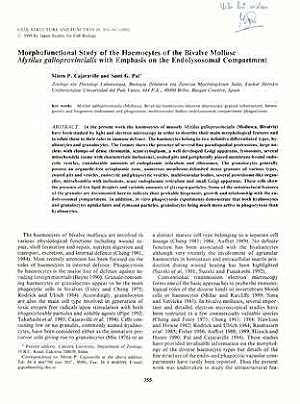cajarville pal (1 résultats)
Type d'article
- Tous les types d'articles
- Livres (1)
- Magazines & Périodiques
- Bandes dessinées
- Partitions de musique
- Art, Affiches et Gravures
- Photographies
- Cartes
-
Manuscrits &
Papiers anciens
Etat
- Tous
- Neuf
- Ancien ou d'occasion
Reliure
- Toutes
- Couverture rigide
- Couverture souple
Particularités
- Edition originale
- Signé
- Jaquette
- Avec images
- Sans impression à la demande
Pays
Evaluation du vendeur
-
Morphofunctional Study of the Haemocytes of the Bivalve Mollusc Mytilus galloprovincialis with Emphasis on the Endolysosomal Compartment
Date d'édition : 1995
Vendeur : ConchBooks, Harxheim, Allemagne
In the present work the haemocytes of mussels Mytilus galloprovincialis (Mollusca, Bivalvia) have been studied by light and electron microscopy in order to describe their main morphological features and to relate these to their roles in immune defence. The haemocytes belong to two definitive differentiated types, hyalinocytes and granulocytes. The former shows the presence of several fine pseudopodial protrusions, large nucleus with clumps of dense chromatin, scant cytoplasm, a well developed Golgi apparatus, lysosomes, several mitochondria (some with characteristic inclusions), coated pits and peripherally placed membrane-bound endocytic vesicles, considerable amounts of endoplasmic reticulum and ribosomes. The granulocytes generally possess an organelle-free ectoplasmic zone, numerous membrane-delimited dense granules of various types, coated pits and vesicles, endocytic and phagocytic vesicles, multivesicular bodies, several peroxisome-like organelles, mitochondria with inclusions, scant endoplasmic reticulum and small Golgi apparatus. These cells show the presence of few lipid droplets and variable amounts of glycogen particles. Some of the substructural features of the granules are documented here to indicate their probable biogenesis, growth and relationship with the endolysosomal compartment. In addition, in vitro phagocytosis experiments demonstrate that both hyalinocytes and granulocytes uptake latex and zymosan particles, granulocytes being much more active in phagocytosis than hyalinocytes. 13 pp., 23 figs, 4.


